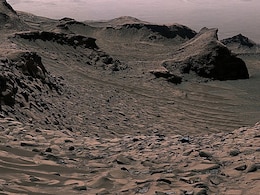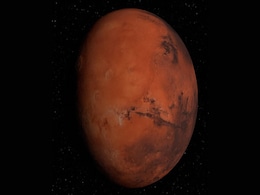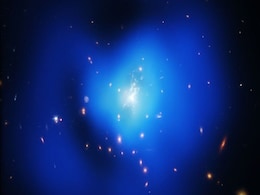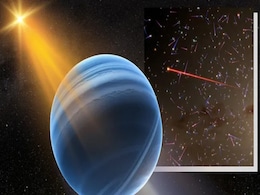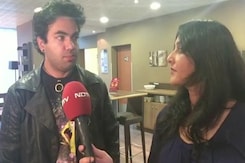Nasa Discovery
- All
- News
- Videos
-

Neighbouring Planets To Faraway Galaxies, NASA Shares Stunning Pics To Celebrate Hubble Telescope's 35th Anniversary
- Thursday April 24, 2025
- Science | Edited by Bhavya Sukheja
To mark the 35th anniversary of the Hubble Space Telescope, the US space agency NASA released new high-definition photos taken with the technological marvel.
-
 www.ndtv.com
www.ndtv.com
-

NASA Hubble Space Telescope Helps Confirm the First Solitary Black Hole
- Friday April 18, 2025
- Written by Gadgets 360 Staff
In the Sagittarius constellation, a lone and first-ever solitary black hole has been discovered by a team of scientists. Although the discovery began in the year 2011, the observations have confirmed it recently. The size of this black hole is as massive as seven times of the sun. Despite the conflicts and differences of observations by another tea...
-
 www.gadgets360.com
www.gadgets360.com
-

Signs of Alien Life Detected on Nearby Exoplanet Using NASA’s James Webb Space Telescope
- Friday April 18, 2025
- Written by Gadgets 360 Staff
Astronomers have detected possible biosignature gases, including dimethyl sulfide (DMS), in the atmosphere of exoplanet K2-18b using NASA’s James Webb Space Telescope. Located in the habitable zone, this “Hycean” world may host a vast ocean and a hydrogen-rich atmosphere, raising intriguing possibilities about alien life. Further research is ...
-
 www.gadgets360.com
www.gadgets360.com
-

NASA Curiosity Rover Potentially Deciphers Mars’ Missing Carbonate Mystery
- Friday April 18, 2025
- Written by Gadgets 360 Staff
NASA’s Curiosity rover potentially ended the mystery of the ancient atmosphere and missing carbonates. The research uncovers the potential reasons behind the temperature of the planet Mars and how it has supported the liquid water on the planet. Explore the findings and the discoveries made by NASA’s Curiosity rover.
-
 www.gadgets360.com
www.gadgets360.com
-

Two New Exoplanets Found Orbiting a Star in Draco Constellation
- Wednesday April 2, 2025
- Written by Gadgets 360 Staff
Astronomers have identified two exoplanets, TOI-1453 b and TOI-1453 c, orbiting a star 250 light-years away in Draco. The planets, a super-Earth and a sub-Neptune, were detected using NASA’s TESS satellite and the HARPS-N spectrograph. TOI-1453 b is a rocky planet orbiting close to its star, while TOI-1453 c is twice Earth’s size and may have a...
-
 www.gadgets360.com
www.gadgets360.com
-

Supernova Remnants Found in Oceanic Samples, Scientists Look to Moon
- Wednesday March 26, 2025
- Written by Gadgets 360 Staff
Scientists have identified supernova debris in deep-sea sediments, including a rare plutonium isotope linked to a kilonova. Researchers believe a neutron star collision occurred nearly 10 million years ago, scattering radioactive material across space. To validate this theory, they plan to analyze lunar soil, which remains undisturbed by Earth's ge...
-
 www.gadgets360.com
www.gadgets360.com
-

NASA's MMS Mission Marks 10 Years of Magnetic Reconnection Discoveries
- Monday March 17, 2025
- Written by Gadgets 360 Staff
NASA's Magnetospheric Multiscale (MMS) mission has completed a decade of discoveries, advancing the study of magnetic reconnection—a crucial process in space physics. The four-satellite fleet has enabled over 1,500 research papers, refining theories and revealing unexpected reconnection locations. The mission has also set records for GPS tracking...
-
 www.gadgets360.com
www.gadgets360.com
-

New Research Reveals Mars’ Red Colour Linked to Ancient Water Presence
- Monday March 3, 2025
- Written by Gadgets 360 Staff
A recent study suggests that Mars’ red hue originates from ferrihydrite, an iron oxide that forms in water-rich environments. Scientists recreated Martian dust in labs and found that the mineral remained stable despite the planet’s dry conditions. Data from orbiting spacecraft and rovers confirm this discovery, reshaping theories about Mars’ ...
-
 www.gadgets360.com
www.gadgets360.com
-

NASA Supercomputer Finds Spiral Structure in the Oort Cloud’s Inner Region
- Thursday February 27, 2025
- Written by Gadgets 360 Staff
A NASA supercomputer model suggests that the Oort Cloud’s inner structure forms a spiral, influenced by galactic tides. The Oort Cloud, a distant icy shell surrounding the solar system, has remained unobservable due to its vast distance. Researchers believe this finding could redefine understanding of how comets originate and interact with cosmic...
-
 www.gadgets360.com
www.gadgets360.com
-

Unusual X-ray Flash in Large Magellanic Cloud Puzzles Astronomers
- Tuesday February 25, 2025
- Written by Gadgets 360 Staff
A brief yet intense X-ray flash, XRT 200515, was detected in NASA's Chandra telescope data from 2000. The signal, originating from the Large Magellanic Cloud, has left scientists debating its cause. Possible explanations include a neutron star pulling in gas from a companion star or a powerful flare from a distant magnetar. Researchers also specula...
-
 www.gadgets360.com
www.gadgets360.com
-

JWST Identifies Cooling Gas in Phoenix Cluster, Unlocking Star Formation Process
- Thursday February 20, 2025
- Written by Gadgets 360 Staff
The James Webb Space Telescope has detected the missing cooling gas in the Phoenix Cluster, a galaxy cluster located 5.8 billion light-years away. Researchers used the Mid-Infrared Instrument (MIRI) to identify gas at around 540,000 degrees Fahrenheit trapped in cavities within the cluster. This discovery resolves a long-standing mystery of how sta...
-
 www.gadgets360.com
www.gadgets360.com
-

Curiosity Rover Finds Evidence of Liquid Water on Mars, Expanding Habitability Timeline
- Tuesday February 18, 2025
- Written by Gadgets 360 Staff
Reports from NASA’s Curiosity rover reveal evidence of ancient liquid water on Mars, challenging previous models. Images from Gale Crater show wave-like ripples, similar to Earth’s lakebeds. Scientists suggest the findings indicate Mars once had a denser atmosphere, which allowed liquid water to exist longer than previously believed. This disco...
-
 www.gadgets360.com
www.gadgets360.com
-

A Neptune-Like Exoplanet Is Racing Through Space at Record Speed
- Monday February 17, 2025
- Written by Gadgets 360 Staff
Scientists have detected an exoplanet racing through space at 1.2 million mph, making it the fastest known planet. The Neptune-sized world orbits a hypervelocity star, first hinted at in 2011 via gravitational microlensing. Astronomers, using Keck Observatory and Gaia data, have confirmed the system’s extreme speed, suggesting it may even leave t...
-
 www.gadgets360.com
www.gadgets360.com
-

Webb Telescope Unveils Hidden Process Behind Star Formation in Phoenix Cluster
- Friday February 14, 2025
- Written by Gadgets 360 Staff
NASA’s James Webb Space Telescope has uncovered the missing link in star formation within the Phoenix galaxy cluster. By mapping intermediate-temperature gas, researchers identified a crucial phase of cooling that was previously undetected. This discovery explains why the cluster’s supermassive black hole does not fully prevent star formation, ...
-
 www.gadgets360.com
www.gadgets360.com
-

May 2024 Solar Storm Triggers Unusual Radiation Belts, Raising Space Safety Concerns
- Wednesday February 12, 2025
- Written by Gadgets 360 Staff
A significant solar storm in May 2024 led to the creation of two temporary radiation belts, detected by the CIRBE satellite in June. One belt contained high-energy electrons, while the other was rich in protons, a rare occurrence. While the electron belt dissipated in three months, the proton-dominated belt remains, potentially affecting space miss...
-
 www.gadgets360.com
www.gadgets360.com
-

Neighbouring Planets To Faraway Galaxies, NASA Shares Stunning Pics To Celebrate Hubble Telescope's 35th Anniversary
- Thursday April 24, 2025
- Science | Edited by Bhavya Sukheja
To mark the 35th anniversary of the Hubble Space Telescope, the US space agency NASA released new high-definition photos taken with the technological marvel.
-
 www.ndtv.com
www.ndtv.com
-

NASA Hubble Space Telescope Helps Confirm the First Solitary Black Hole
- Friday April 18, 2025
- Written by Gadgets 360 Staff
In the Sagittarius constellation, a lone and first-ever solitary black hole has been discovered by a team of scientists. Although the discovery began in the year 2011, the observations have confirmed it recently. The size of this black hole is as massive as seven times of the sun. Despite the conflicts and differences of observations by another tea...
-
 www.gadgets360.com
www.gadgets360.com
-

Signs of Alien Life Detected on Nearby Exoplanet Using NASA’s James Webb Space Telescope
- Friday April 18, 2025
- Written by Gadgets 360 Staff
Astronomers have detected possible biosignature gases, including dimethyl sulfide (DMS), in the atmosphere of exoplanet K2-18b using NASA’s James Webb Space Telescope. Located in the habitable zone, this “Hycean” world may host a vast ocean and a hydrogen-rich atmosphere, raising intriguing possibilities about alien life. Further research is ...
-
 www.gadgets360.com
www.gadgets360.com
-

NASA Curiosity Rover Potentially Deciphers Mars’ Missing Carbonate Mystery
- Friday April 18, 2025
- Written by Gadgets 360 Staff
NASA’s Curiosity rover potentially ended the mystery of the ancient atmosphere and missing carbonates. The research uncovers the potential reasons behind the temperature of the planet Mars and how it has supported the liquid water on the planet. Explore the findings and the discoveries made by NASA’s Curiosity rover.
-
 www.gadgets360.com
www.gadgets360.com
-

Two New Exoplanets Found Orbiting a Star in Draco Constellation
- Wednesday April 2, 2025
- Written by Gadgets 360 Staff
Astronomers have identified two exoplanets, TOI-1453 b and TOI-1453 c, orbiting a star 250 light-years away in Draco. The planets, a super-Earth and a sub-Neptune, were detected using NASA’s TESS satellite and the HARPS-N spectrograph. TOI-1453 b is a rocky planet orbiting close to its star, while TOI-1453 c is twice Earth’s size and may have a...
-
 www.gadgets360.com
www.gadgets360.com
-

Supernova Remnants Found in Oceanic Samples, Scientists Look to Moon
- Wednesday March 26, 2025
- Written by Gadgets 360 Staff
Scientists have identified supernova debris in deep-sea sediments, including a rare plutonium isotope linked to a kilonova. Researchers believe a neutron star collision occurred nearly 10 million years ago, scattering radioactive material across space. To validate this theory, they plan to analyze lunar soil, which remains undisturbed by Earth's ge...
-
 www.gadgets360.com
www.gadgets360.com
-

NASA's MMS Mission Marks 10 Years of Magnetic Reconnection Discoveries
- Monday March 17, 2025
- Written by Gadgets 360 Staff
NASA's Magnetospheric Multiscale (MMS) mission has completed a decade of discoveries, advancing the study of magnetic reconnection—a crucial process in space physics. The four-satellite fleet has enabled over 1,500 research papers, refining theories and revealing unexpected reconnection locations. The mission has also set records for GPS tracking...
-
 www.gadgets360.com
www.gadgets360.com
-

New Research Reveals Mars’ Red Colour Linked to Ancient Water Presence
- Monday March 3, 2025
- Written by Gadgets 360 Staff
A recent study suggests that Mars’ red hue originates from ferrihydrite, an iron oxide that forms in water-rich environments. Scientists recreated Martian dust in labs and found that the mineral remained stable despite the planet’s dry conditions. Data from orbiting spacecraft and rovers confirm this discovery, reshaping theories about Mars’ ...
-
 www.gadgets360.com
www.gadgets360.com
-

NASA Supercomputer Finds Spiral Structure in the Oort Cloud’s Inner Region
- Thursday February 27, 2025
- Written by Gadgets 360 Staff
A NASA supercomputer model suggests that the Oort Cloud’s inner structure forms a spiral, influenced by galactic tides. The Oort Cloud, a distant icy shell surrounding the solar system, has remained unobservable due to its vast distance. Researchers believe this finding could redefine understanding of how comets originate and interact with cosmic...
-
 www.gadgets360.com
www.gadgets360.com
-

Unusual X-ray Flash in Large Magellanic Cloud Puzzles Astronomers
- Tuesday February 25, 2025
- Written by Gadgets 360 Staff
A brief yet intense X-ray flash, XRT 200515, was detected in NASA's Chandra telescope data from 2000. The signal, originating from the Large Magellanic Cloud, has left scientists debating its cause. Possible explanations include a neutron star pulling in gas from a companion star or a powerful flare from a distant magnetar. Researchers also specula...
-
 www.gadgets360.com
www.gadgets360.com
-

JWST Identifies Cooling Gas in Phoenix Cluster, Unlocking Star Formation Process
- Thursday February 20, 2025
- Written by Gadgets 360 Staff
The James Webb Space Telescope has detected the missing cooling gas in the Phoenix Cluster, a galaxy cluster located 5.8 billion light-years away. Researchers used the Mid-Infrared Instrument (MIRI) to identify gas at around 540,000 degrees Fahrenheit trapped in cavities within the cluster. This discovery resolves a long-standing mystery of how sta...
-
 www.gadgets360.com
www.gadgets360.com
-

Curiosity Rover Finds Evidence of Liquid Water on Mars, Expanding Habitability Timeline
- Tuesday February 18, 2025
- Written by Gadgets 360 Staff
Reports from NASA’s Curiosity rover reveal evidence of ancient liquid water on Mars, challenging previous models. Images from Gale Crater show wave-like ripples, similar to Earth’s lakebeds. Scientists suggest the findings indicate Mars once had a denser atmosphere, which allowed liquid water to exist longer than previously believed. This disco...
-
 www.gadgets360.com
www.gadgets360.com
-

A Neptune-Like Exoplanet Is Racing Through Space at Record Speed
- Monday February 17, 2025
- Written by Gadgets 360 Staff
Scientists have detected an exoplanet racing through space at 1.2 million mph, making it the fastest known planet. The Neptune-sized world orbits a hypervelocity star, first hinted at in 2011 via gravitational microlensing. Astronomers, using Keck Observatory and Gaia data, have confirmed the system’s extreme speed, suggesting it may even leave t...
-
 www.gadgets360.com
www.gadgets360.com
-

Webb Telescope Unveils Hidden Process Behind Star Formation in Phoenix Cluster
- Friday February 14, 2025
- Written by Gadgets 360 Staff
NASA’s James Webb Space Telescope has uncovered the missing link in star formation within the Phoenix galaxy cluster. By mapping intermediate-temperature gas, researchers identified a crucial phase of cooling that was previously undetected. This discovery explains why the cluster’s supermassive black hole does not fully prevent star formation, ...
-
 www.gadgets360.com
www.gadgets360.com
-

May 2024 Solar Storm Triggers Unusual Radiation Belts, Raising Space Safety Concerns
- Wednesday February 12, 2025
- Written by Gadgets 360 Staff
A significant solar storm in May 2024 led to the creation of two temporary radiation belts, detected by the CIRBE satellite in June. One belt contained high-energy electrons, while the other was rich in protons, a rare occurrence. While the electron belt dissipated in three months, the proton-dominated belt remains, potentially affecting space miss...
-
 www.gadgets360.com
www.gadgets360.com




